Simple Watercolour Cake Tutorial
This post may contain affiliate links to products I recommend. I receive a small commission at no cost to you if you make a purchase using my link.
A step by step tutorial for creating a fool-proof, easy watercolour effect on a fondant covered cake. If you’ve ever been too nervous to paint on a cake, then this simple watercolour-without-water technique is for you!
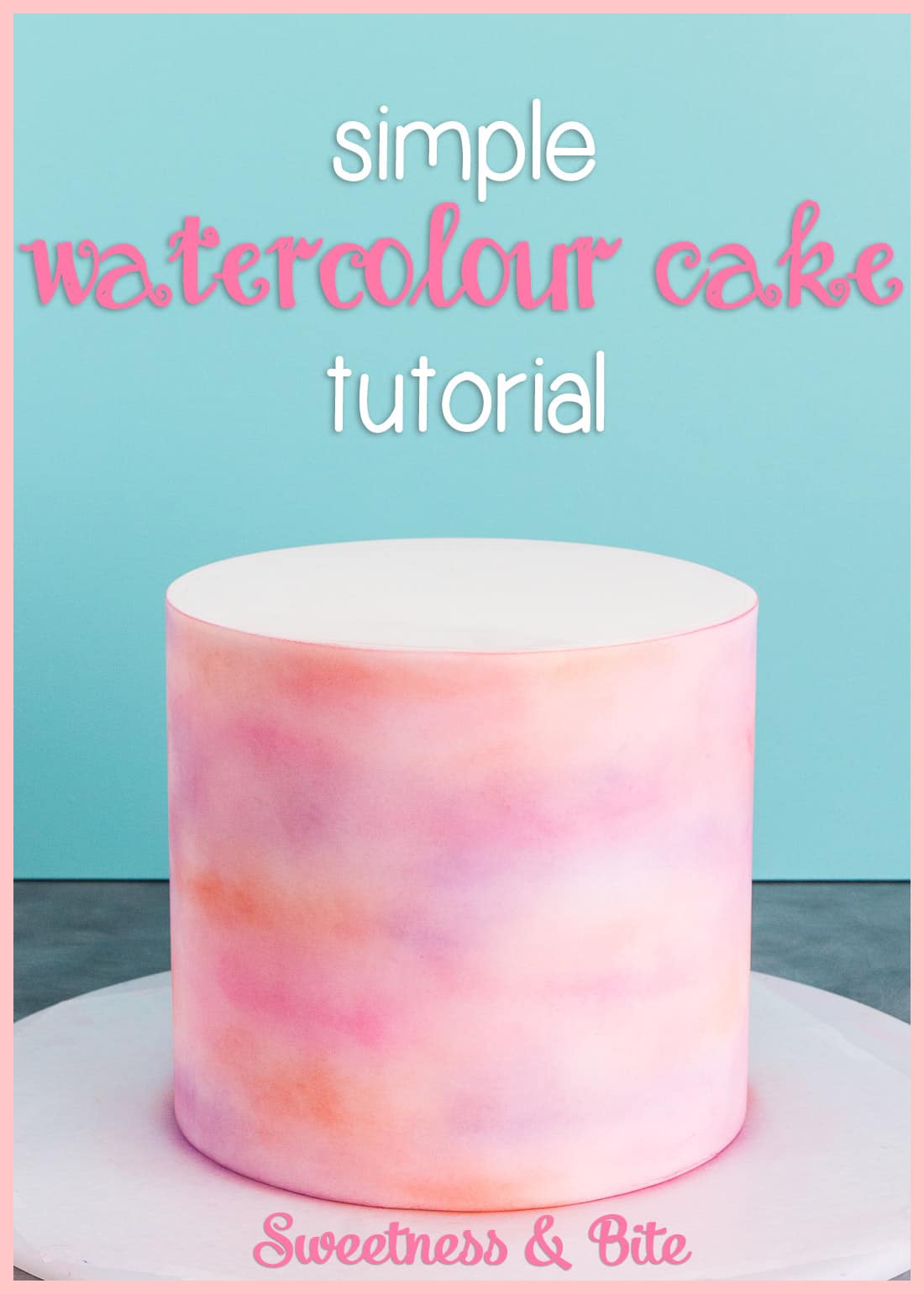
I’d like you to pretend that this is a witty and clever first paragraph to this post. Here’s why I need you to pretend: just as I was falling asleep last night, the perfect post opening popped into my head. I felt quite pleased with myself, but then realised I literally did not have the energy to roll over, grab my phone and write it down. My body had basically given up for the night, and there was no moving it.
I knew, as I lay there, that I wasn’t going to remember. I replayed that clever intro to myself over and over as I fell asleep, in the hopes that I would remember. But this morning I woke up and knew. I just knew that I didn’t know. Ugh.
I do vaguely remember that it somehow tied in my last post, the tutorial on the gumpaste name cake topper that I made for my niece’s birthday cake. Because this tutorial is another one I photographed while making that cake, detailing how I did the watercolour effect on the top tier.
So now that you’re done imagining my super clever, super witty intro to the post, we’ll just get into it, shall we?
When I decided that I wanted a watercolour effect on the top tier of this cake, I kinda figured I’d have to actually paint it on like watercolour paint. Makes sense, right? Do what you’d do with watercolour, only do it with food colouring.
Turns out my attempts just didn’t at look at all how I wanted, which was a very light wash of colour in several shades that could be blended together. Whether I used gel colours or petal dusts mixed with vodka or cake decorator’s alcohol, every combination I tried just kind of smeared together and basically looked awful. The fondant got too wet, and the colours wouldn’t blend nicely.
Then, in one of those moments when you realise the answer is simple, I tried just dusting the petal dusts straight onto the fondant. They blended together beautifully! And it allowed me to build up the colour gradually, so it was very hard to make mistakes.
Plus, it was so ridiculously easy.
Even though it is very easy, I do suggest trying out the technique on a rolled out piece of spare fondant, just to check that your colours are blending nicely together. If the colours look as though they might be too dark and intense for the look you want, you can mix in a little cornstarch to lighten the colour.
Right, let’s do this!
How to Decorate a Watercolour Fondant Cake
First things first, you’ll need a fondant covered cake. I find that colour takes better on a freshly covered cake, so I waited an hour or so after covering the cake, until the surface of the fondant had dried and set just a little bit. You can do this on a dry cake, it will just take longer to build up the colour.
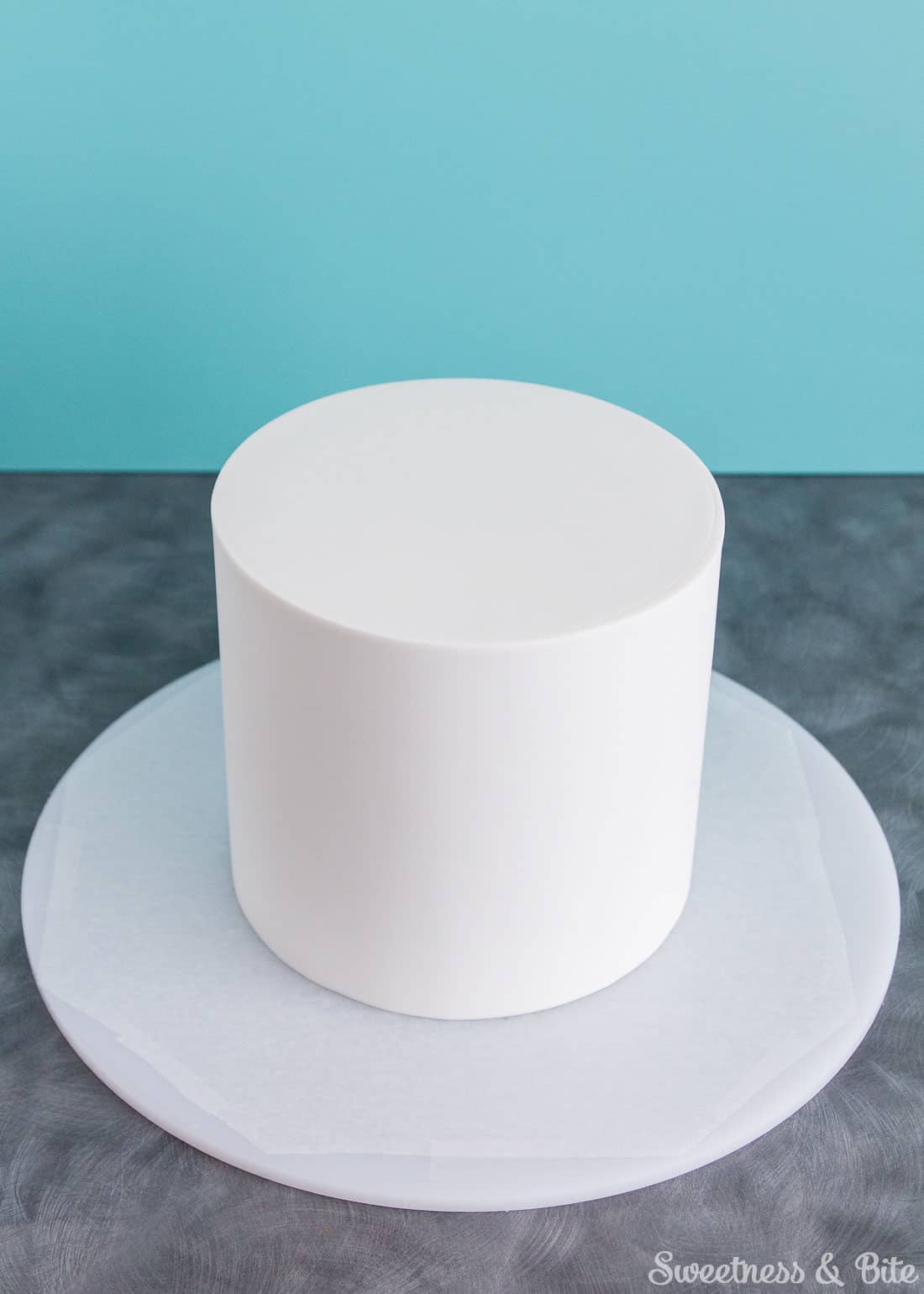
Bear in mind that the colour will settle in any dents or cracks in your fondant, emphasising any flaws, so you’ll need to be very careful around any dodgy bits.
I chose to wrap this cake in fondant rather than cover it all in one, as I always get patches of elephant skin when I use fondant. No matter what I do, kneading lots, rolling fast, smoothing quickly, it just happens. Fondant hates me. But when wrapping it like this I get a much smoother result.
You’ll be able to see at the back of this cake what I mean about the colour settling in cracks, as it makes the back seam of the cake very visible.
Now for the colours – petal dusts, to be precise. Try to choose colours that will look good layered over one another, and blend nicely together.
Another important thing to check is that the colours you are using are food grade and are safe to be consumed. Some petal dusts and powder colours are intended for elements that can be removed before the cake is eaten.
I used two Rolkem rainbow powders, Deep Rose and Orchid Mauve, a Caroline’s Sugar Art pink, and a kind of peachy colour I made using a Rolkem Watermelon powder with a bit of yellow added.
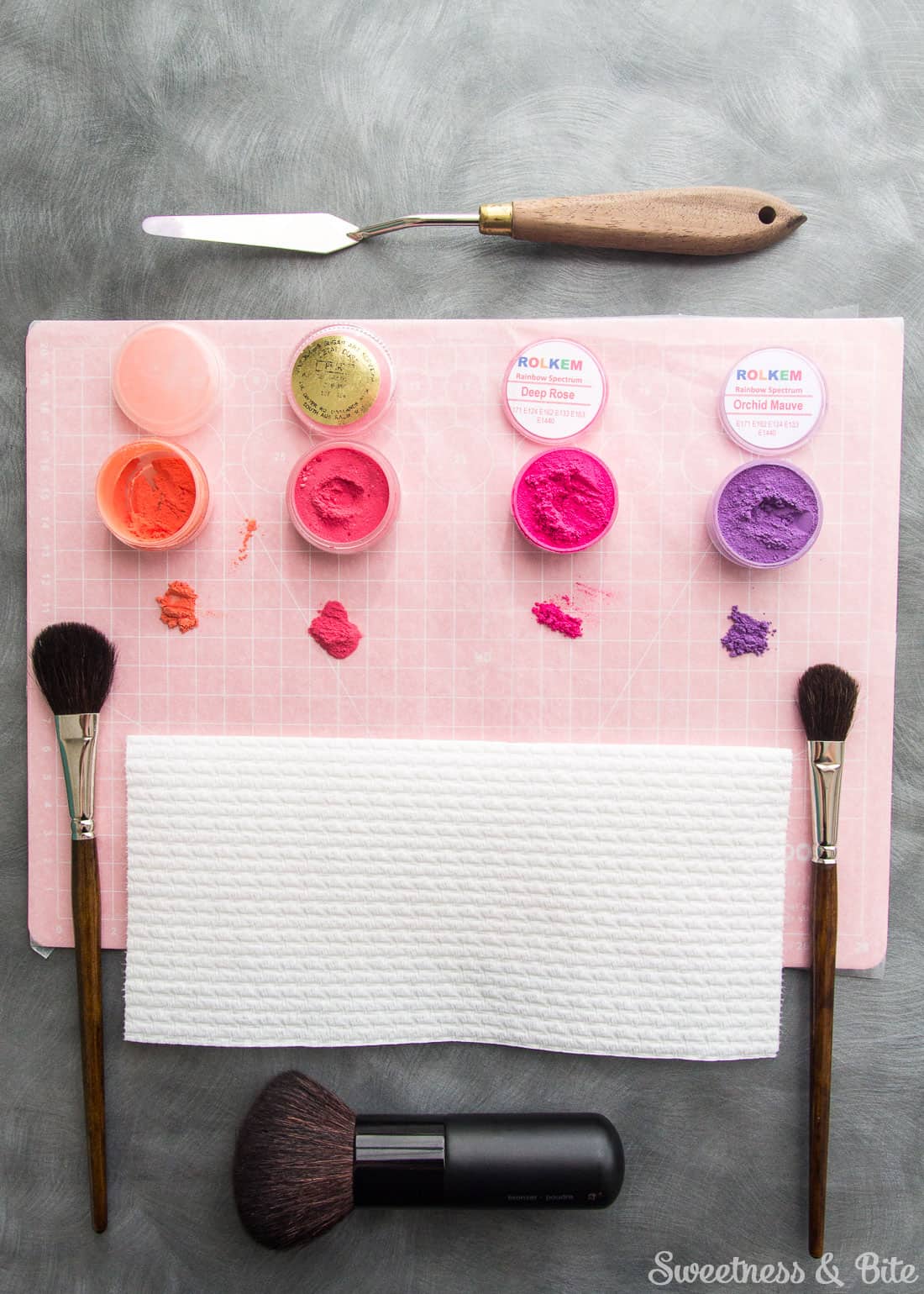
This is how I like to lay out the colours, so I know what is what and can easily get more out of the container, but working in small quantities so there is less chance for “omyfreakin’gosh I did not want that much colour on there!” moments.
I taped a piece of waxed paper to a cutting mat to make clean up easy, as I, ahem, learned from experience that colour dusts will eventually go through a paper towel and end up on the bench.
It is handy though to have a piece of folded paper towel to dab excess powder off the brush before applying it to the cake.
I played with a range of paintbrushes on my test piece of fondant, and worked out that I liked these slightly fluffy artists brushes pictured above, and also a rounded-tip flat foundation makeup brush. A giant fat fluffy brush (mine is a bronzer brush) is good for buffing over the colours to blend them at the end.
Hopefully, it goes without saying that the brushes should have only ever been used for cakes, don’t go all Picasso on a canvas and then use those brushes for this. Or apply a full face of Kardashian makeup and then use your bronzer brush on a cake.
But having said that if you’re capable of Picasso-like art then you probably don’t need some random little tutorial on the internets, written by a make-it-up-as-she-goes-along blogger/cake decorator to tell you how to pretty up a cake with colours and brushes. And if you’re a Kardashian, well I’m sure you’d probably just pay someone to make you a cake, right?
Start applying the colour at the back of the cake, so you can get comfortable before you get to the front. Make sure after tapping your brush into the colour powder, you dab it on the paper towel to remove the excess.
It is always, always better to start off light and add more colour – you can’t take it away once it’s there (well, you can try with a bit of vodka, but it’ll be messy). So start slowly and build up the colour.
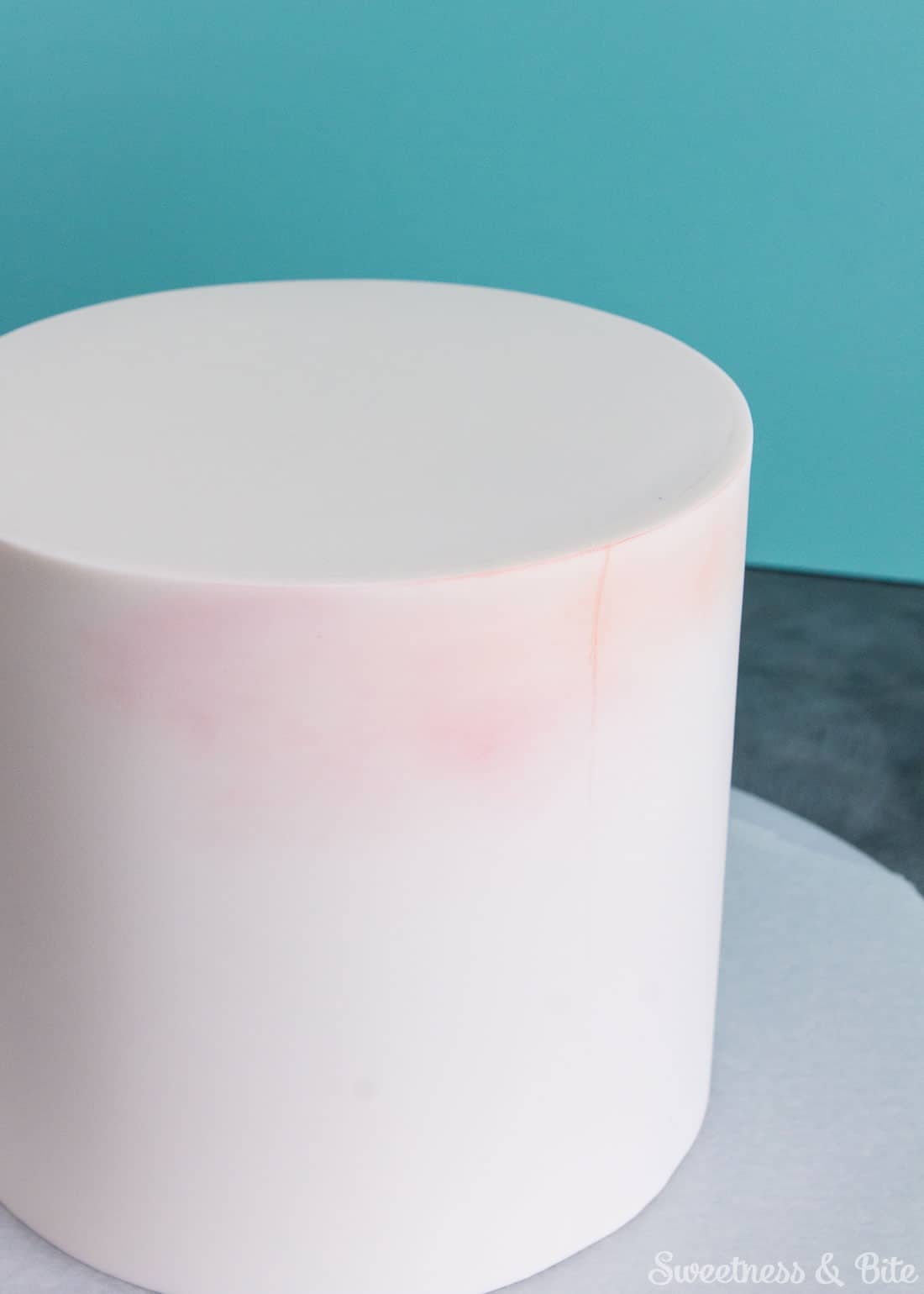
You’ll be able to see now what I mean about the colour emphasising any flaws in the fondant, as the back seam from my wrapped fondant is becoming extra visible now. As the back of the cake wasn’t going to be seen, this didn’t bother me in the slightest, but keep it in mind.
To make an ombre watercolour cake, you can start with your darker or lighter colour and work towards the other at the bottom, or if you’re after a random effect like I was, then, well, make it random.
I found I had to keep making sure I didn’t just end up doing stripes around the cake, so I had to remember to take the colour up and down as well as side to side. Does that make sense? This would be so much easier if you were in my head right now. Actually, you’d probably hate it. It’s messy in there. But at least you’d know for sure what I was on about with this cake.
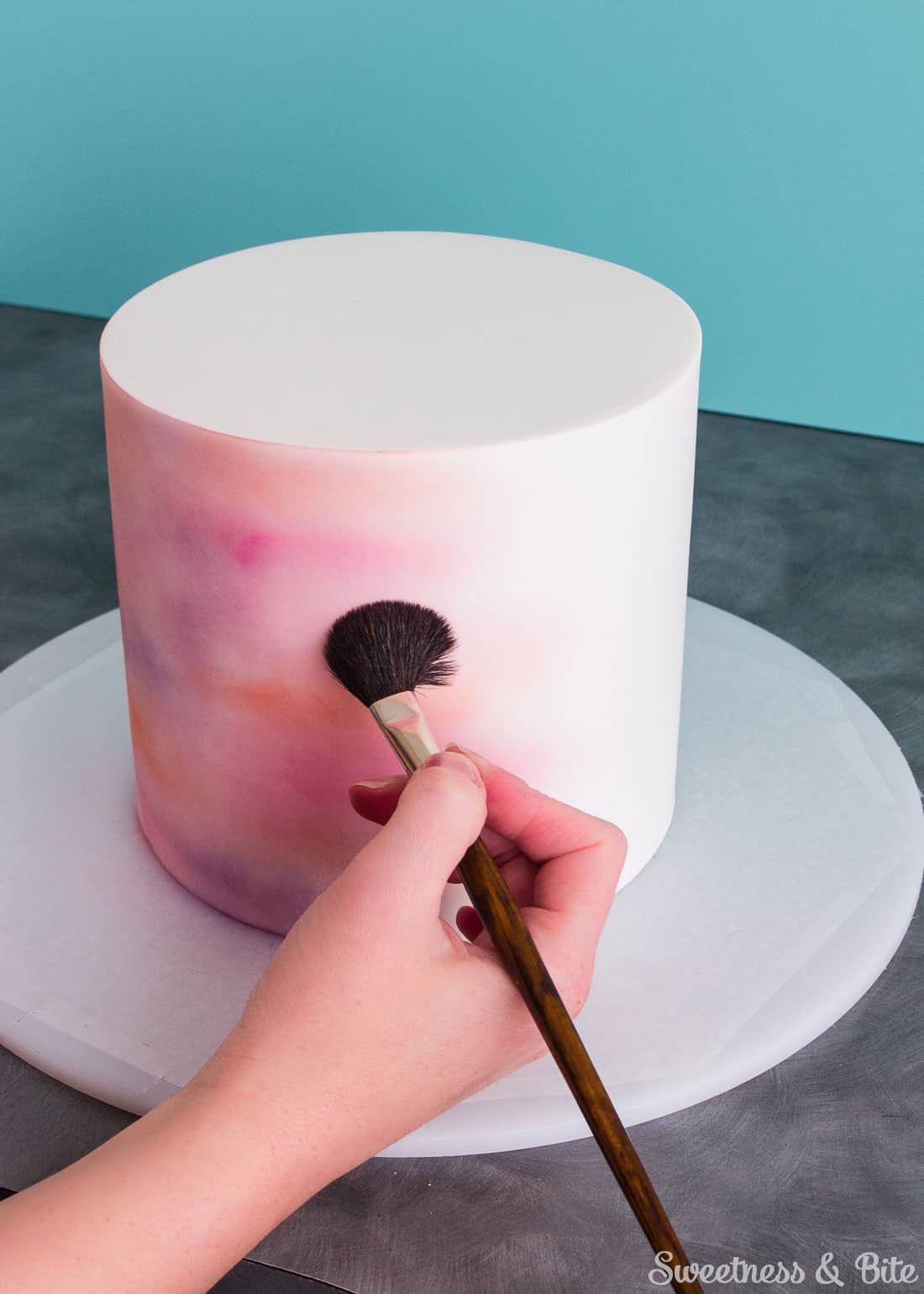
Basically now you just need to keep working around the cake with your colours. I used the fluffier brush, pictured above, to give a light wash, and went back with the foundation brush, pictured below, to darken things up.
If there are any spots you want to be darker than your brush will give you, you can dab a bit of colour on your (clean!) finger and rub it on that way.
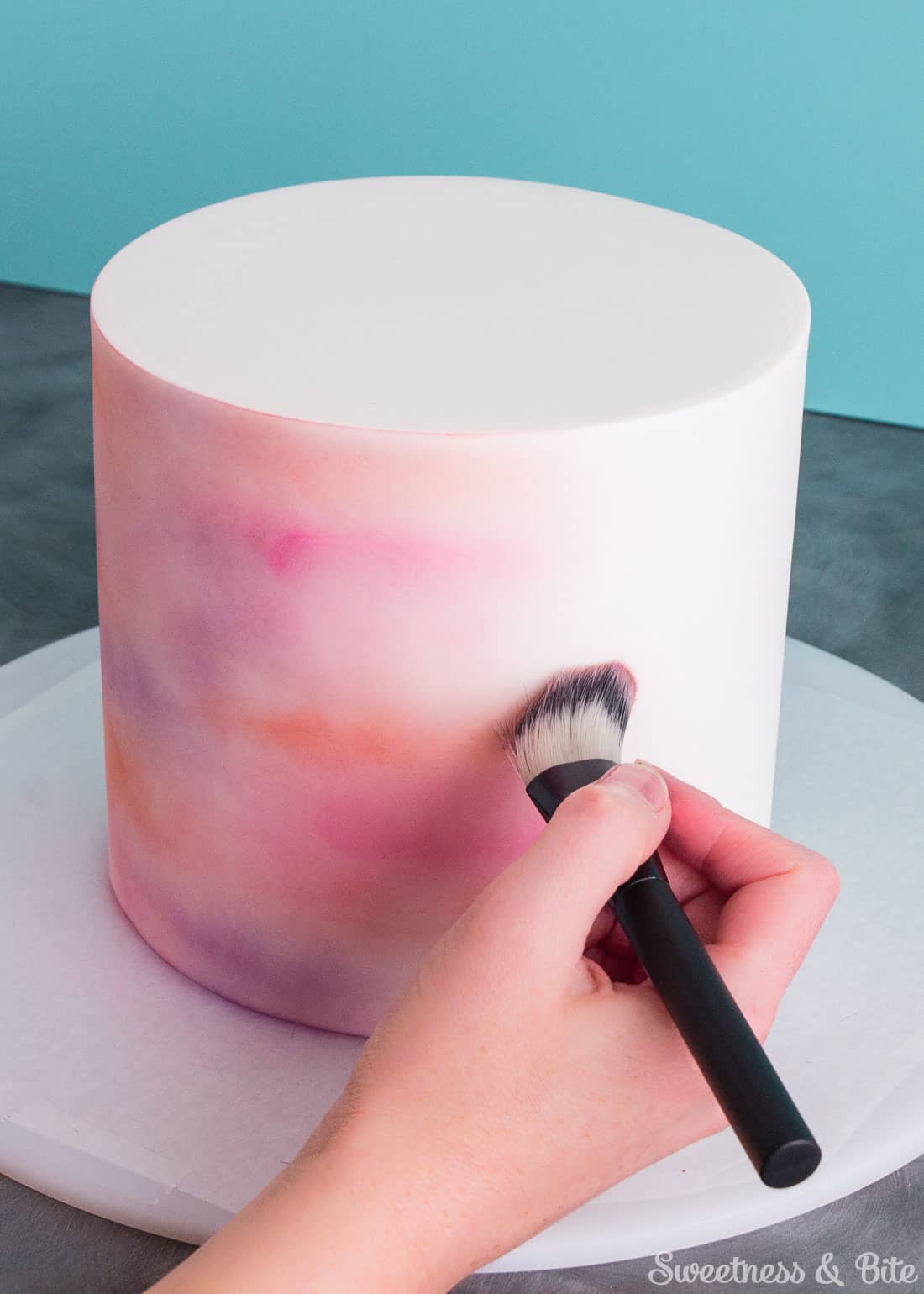
I didn’t bother to colour the top of this cake as it was going to be covered with a chocolate drizzle, but if you want the colour on top too, then just continue it up onto the top, working round in a circle to the centre. Or from the centre out, whatever floats your boat. Or fluffs your brush.
Once you’ve got the colour the way you want it, take the big fluffy brush and use it to buff over the cake. This will blend the colours together a bit more, and remove any excess colour powder.
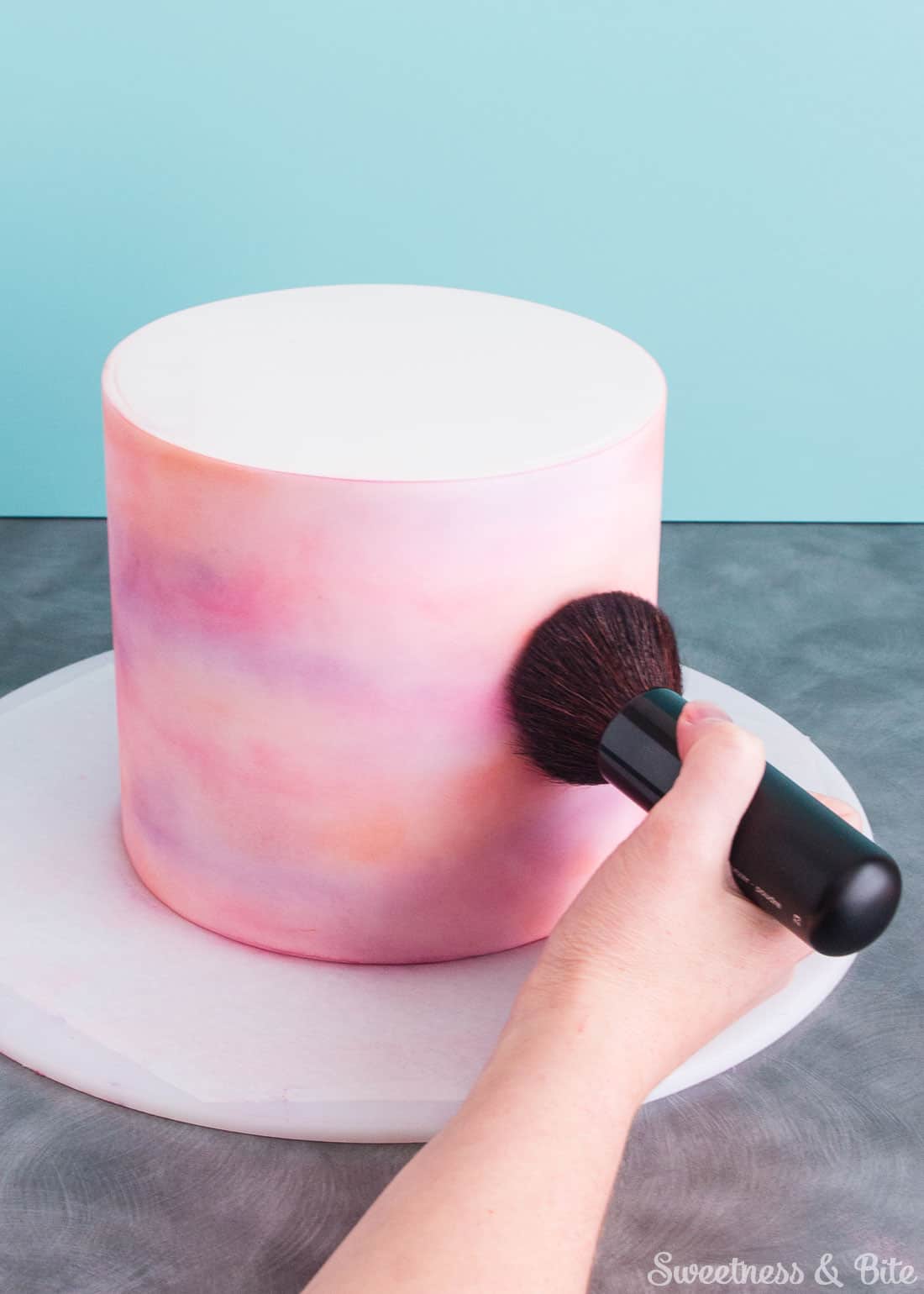
If you wanted a shimmery finish, now would be the time to brush on a pearl lustre dust. If you wanted it to be a bit blotchy like some watercolour paintings are, then you could use a brush dipped in vodka or cake decorator’s alcohol to smudge the colour around. If you’re leaving it au naturel, then voilà…
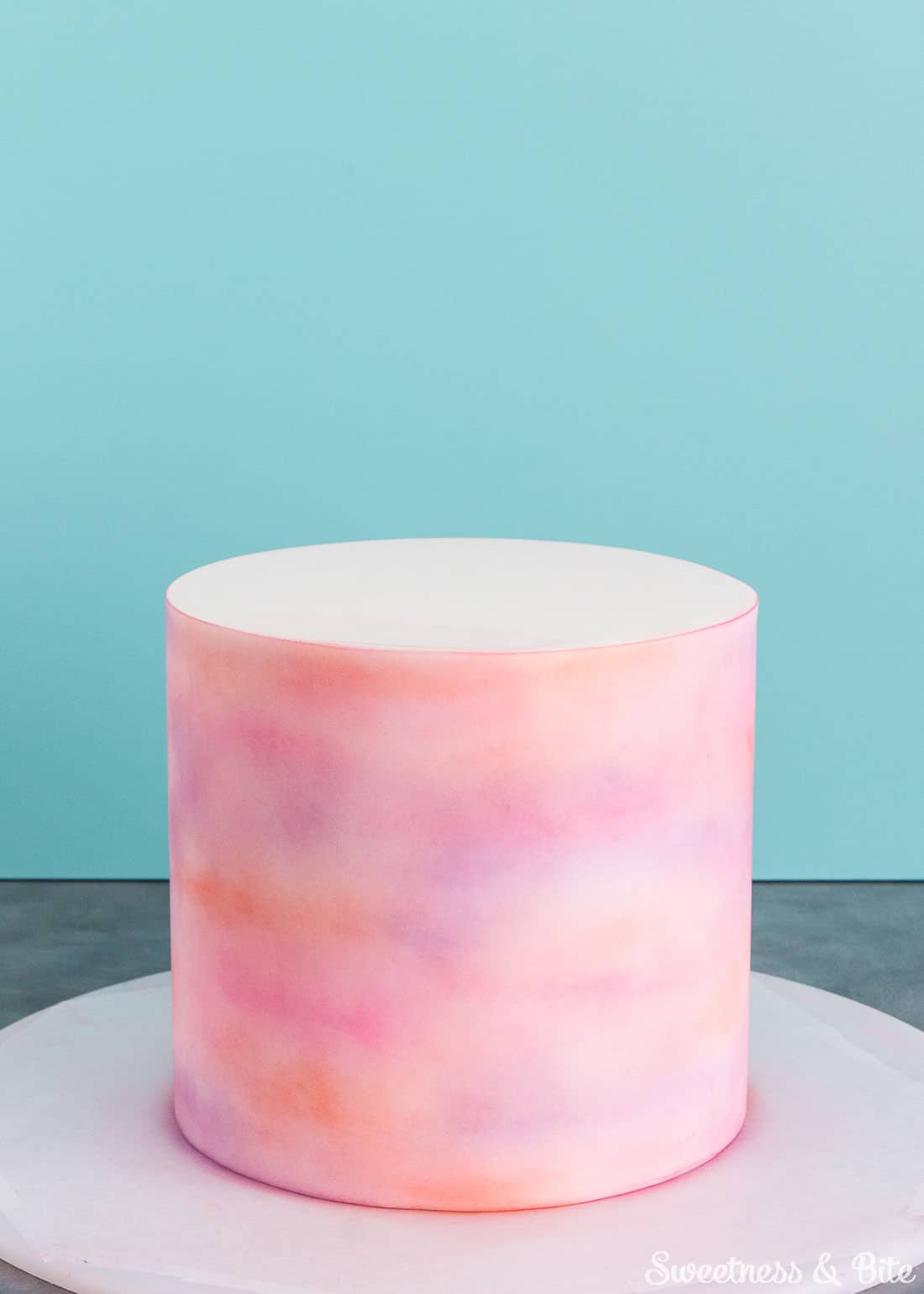
Told you it was easy.
A watercolour fondant cake looks very pretty on its own, but of course, in this case, I popped it onto a sprinkled-covered cake tier and drizzled the top with chocolate, and topped the whole thing off with a custom name cake topper.
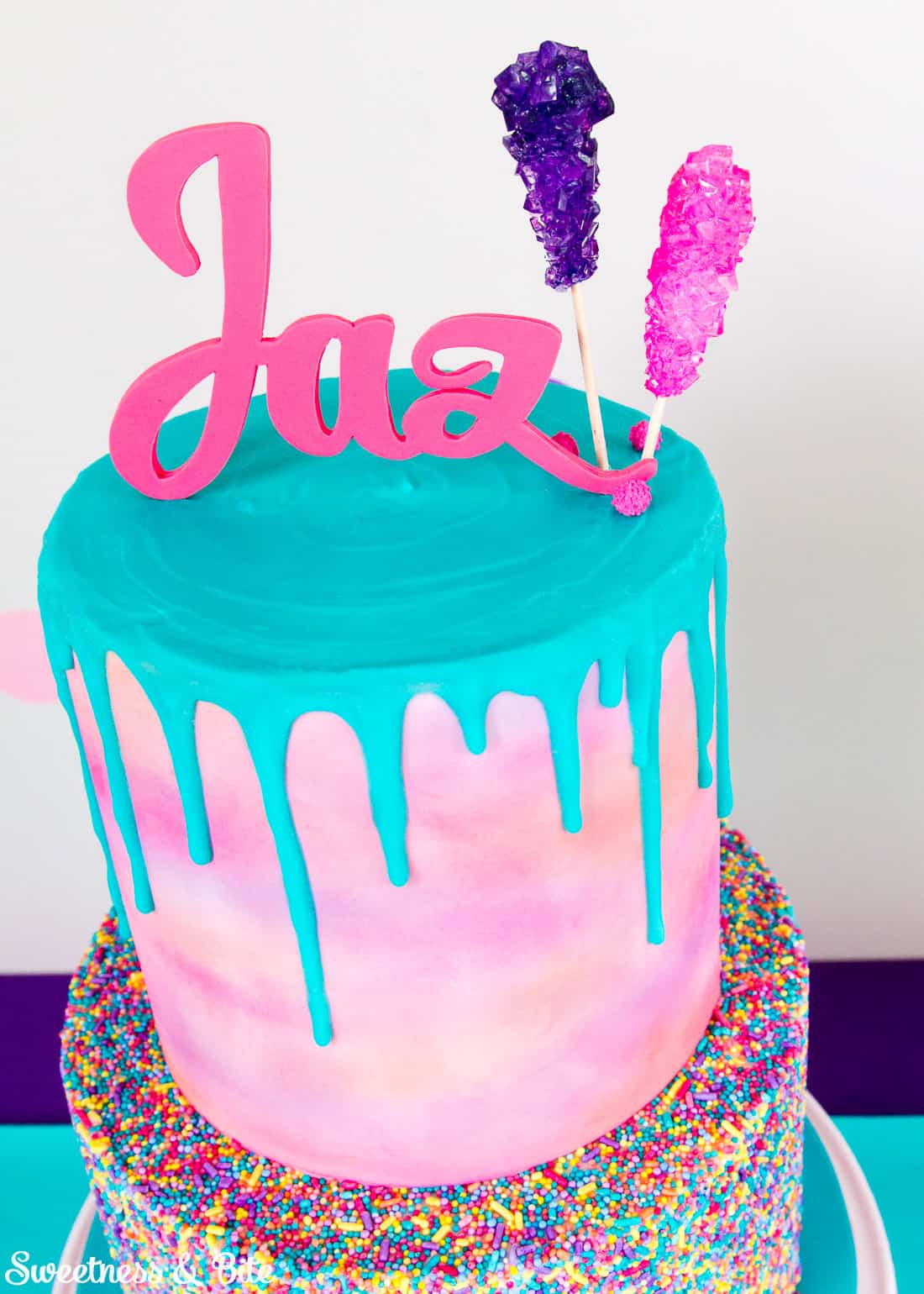
If you have any questions, let me know in the comments below 💜
Happy watercolouring!
~Natalie
xx
You Might Also Like…
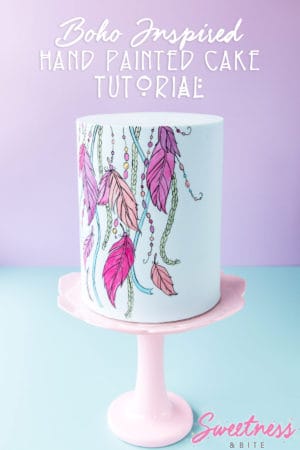
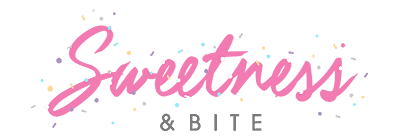
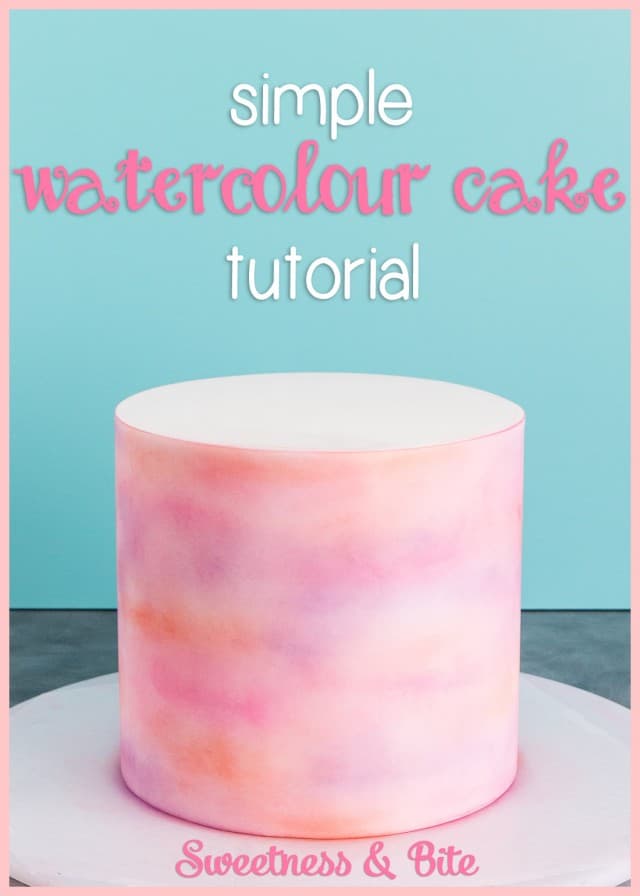
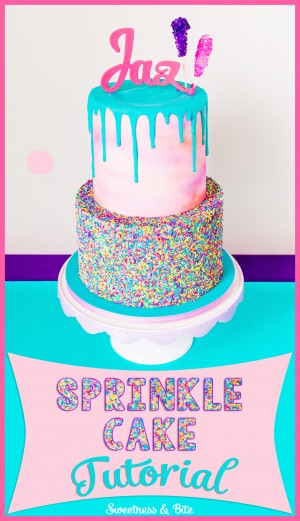
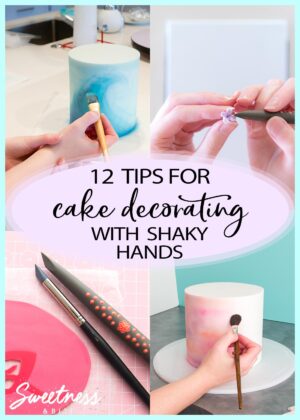
This is freaking awesome, I love it!
Really fascinating, easy to understand, am about to make a cake for my 4 year old granddaughter, with if you can believe a purple apple tree with blossom, and a few my little ponies, not a bad request for a 4year old. You water colour effect will be perfect. Thank you Patricia.
Hi Patricia, sounds like a lovely design for a cake, and definitely not bad for a 4 year old! 😉 I’d love to see the cake when it’s finished if you want to share a picture 🙂
My little pony cake, for my 4yr old Granddaughter. Not sure how to post to you the finished result.
Hi Patricia, I would love to see it! You can email a picture to natalie(at)sweetnessandbite.com (just replace the “(at)” with @, my blog doesn’t like me posting email addresses in the comments) or if you’re on Facebook you can post a picture to my Facebook page 🙂
This is BEAUTIFUL!!!!! I know that you have a tutorial for ganaching a cake but what about covering a cake with fondant? The edges on this cake are crazy sharp!!
Thanks Aisha! To be honest, I’m pretty terrible at applying fondant in the traditional all in one way (I blame the fondant, it rips and tears so it must be rubbish… but actually it’s probably me that’s rubbish 😉 ) but I’m not too bad at wrapping it like I did here, so I’ll think about doing a tutorial for it 🙂
Yes please!!
Yes a tutorial please….
Yes please to fondant wrap!!
I would love that as well! I have never seen fondant look so smooth-fondant hates me as well. Thanks so much for sharing!!!
Can you do this to buttercream if it’s really stiff and cold?
Hi Maria. I’m not sure that this would work so well with buttercream. It couldn’t hurt to try, but I think you may have better luck using a specific buttercream technique like Sweetapolita’s watercolour cake It’s a similar look, but it would be easier to blend the the colours with that technique.
Thank you so much for getting back to me! I have posted a question on a few blogs before but this is the first time I got a response, so thank you.
Hi Maria, you’re very welcome. I love chatting to my readers, so you can pretty much guarantee a reply from me 😉 Even if I don’t know the answer to a question! 🙂
Beautiful work? How do you cut the top edge f the fondant so sharp and straight?
Hi Loretta. I’m planning a tutorial very soon on how to wrap a cake in fondant like this. Long story short though, I cover the top of the cake first, then flip the cake upside down before I wrap the fondant around the sides. That way the clean-cut edge of the fondant ends up as the top seam and it’s easier to buff the seam and make it less visible. Hopefully I’ll have the tutorial done in the next couple of weeks!
Amazing! I love water colour cakes. Now I know how to make one myself.
Hi, I’m Myriam from Belgium and I just love the watercolouring on your cake. Like many others I see, I’m looking forward to the tutorial of the fondant cake wrapping :-). Hope to see it soon, no pressure :-))
Kind regards, Myriam
Hi Myriam! It’s definitely on the cards, I hope to have it done in the next month or so 🙂
I just Have To Say ” I Love Love your writing and your work”! It felt like I was talkingto myself…especially with the word moist! It was great to see you tried and did not succeed at everything the first time. It is so frustrating when I think I am so smart and creative only to find it have made a big, sticky, icky mess. Yeah, I am not alone. I just keep trying like you and eventually discover the perfect solution. (I think I just like the excitement in experimenting..) Keep up the good work!
Hey Cindy. I’m so glad you love it. When I started the blog I knew I didn’t want to come across as someone who knows everything (’cause so don’t, and I can’t live a lie! 😉 ) I think it always helps to know that there are other people out there who screw things up and have to try different ways of doing things. Makes a person feel much less alone when they’re crying on the floor of the kitchen. Other people do that too, right? Right…?!
Can i ask what amount of time it took you to just do the dusting? Rough estimate! So i know how much time to carve out 🙂 Thank you, it’s so beautiful!
Hi Rachael, it actually didn’t take me too long, I couldn’t remember exactly so I checked the times on my photos, and from the first one I took to the last, it was just over an hour. But bear in mind I was stopping regularly to take photos, so it should take you less time than that. Mine was a 6″ cake, so unless your cake is much bigger if you set aside 30-45 minutes to do it then you should be safe. Hope that helps! 🙂
Hi, great work ! It’s only dust and brushes?
Not mixing anything?? Amazing , looks like airbrush and not handmade watercolor ,
Big like ?
Hi there…lovely piece of work…..pristine, clean.
Please the tutorials for the fondant wrap…..am so interested in that.
Thanks.
Hi there Juct, thank you for your lovely comment, and you can find the fondant wrapping tutorial {right here} 🙂
It’s gorgeous! Have a question though will this work on chocolate? Cake pops, chocolate cover oreos? I ship them.
Hi Sofia. You could definitely try it, the colours may not blend as well since the surface of chocolate is slightly stickier than dry fondant, but it would be worth a try 🙂
This is beautiful and I did learn a lot from this piece of art work. I have something coming up and I am going to try this.
Great work..
DASHLEY
I used this technique on my daughter’s cake this weekend as she wanted an airbrush look and I don’t have one! It came out great, but just wanted to say that the colours will deepen overnight (which worked out well for me because I hadn’t got the depth of colour I wanted!) But maybe worth considering if you are going for pastels like this one
Hi Sirena. Ooh, that’s a good thing to keep in mind. I didn’t find that happening with the colours I’ve used, so maybe it depends on the brand? Or maybe the particular colours? Definitely sounds like it was a helpful outcome for your cake though! I’m glad it worked out 🙂
Hello! I’m going to be making an ombré pink to white wedding cake and I’m planning on using this technique for the pink on one of the tiers. I’m then adding gold leaf to parts so wondering if you think the petal dust will be okay once dabbing wet for the gold?
Hi Karissa, it should be fine, as long as you’re only dampening the spots where you want the gold leaf – if any of the pink colour comes off it won’t matter as the gold will cover it. Also just make sure you don’t have too much water on your paintbrush, to make sure it doesn’t cause drips. Sometimes I use vodka or cake decorators alcohol (also known as rose spirit) to attach gold leaf, they both dry faster than water so they’re less likely to smear or drip.
Hope that helps! 🙂
Hi
Can you please let me know your fondant recipe?
Thanks
Bindi
Hi Bindi, I buy ready made fondant, usually either Satin Ice or Pettinice 🙂
Is it possible to do this same technique on buttercream?
Hi Kim, no this technique with the powdered colouring doesn’t really work on buttercream, as the surface of the buttercream isn’t dry enough to dust the colour on and blend it nicely. You would get a better effect by using a watercolour buttercream tutorial like this one from Style Sweet 💜